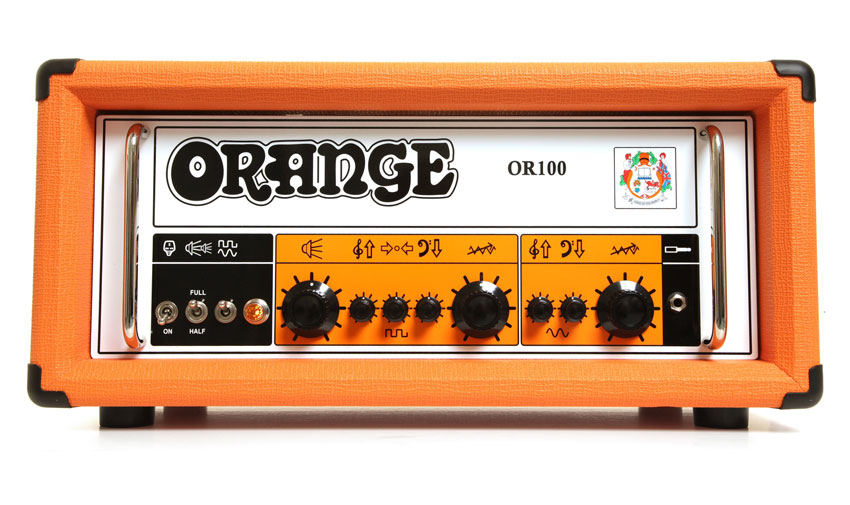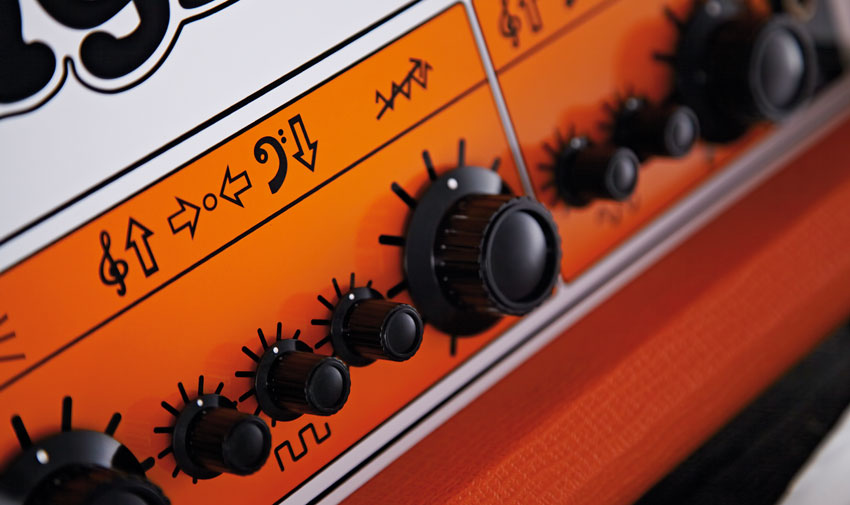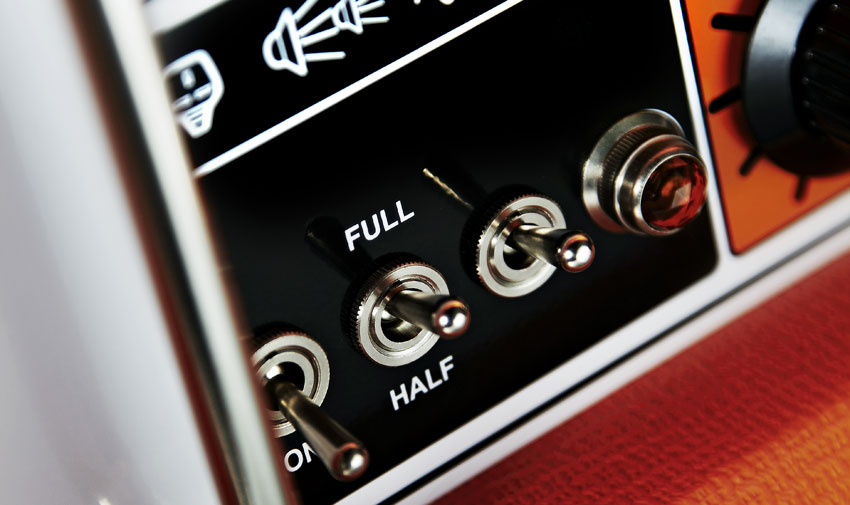MusicRadar Verdict
Orange's considerable heritage and contemporary ingenuity distilled into a world- beating pro valve head.
Pros
- +
Big, breathtaking rock sounds. Confidence-inspiringly chunky build.
Cons
- -
Even the lowest power setting's sweet spot will be too loud for some.
MusicRadar's got your back

Orange OR100H

Controls

Power switching
Orange's headline-grabbing 2013 launch was the innovative VT1000 Valve Tester, reviewed to great acclaim last month. However, back at the NAMM show in Anaheim in January, the arrival of the latest addition to the OR Series set the cardiovascular systems of hard-rock tonehounds across the globe racing. Oozing 'top of the range' from every citrusy pore, the UK-made OR100H is a 100-watt head that draws on the considerable heritage of the company's much-loved early 1970s 'Pics Only' amps.
"Oozing 'top of the range' from every citrusy pore, the UK-made OR100H draws on the considerable heritage of the early 1970s 'Pics Only' amps"
However, a valve-driven effects loop, power scaling and other modern tricks have been added in order for it to deliver the kind of flexibility demanded by professional guitarists on the world's biggest stages.
Orange's technical director and resident valve amp guru Adrian Emsley gives us the skinny on how the OR100H was born.
"It basically came out of the TH100, in some ways," he explains. "Because I did things a bit differently on that, such as having four bias pots, and the 35-, 50-, 70- and 100-watt settings. And I wanted to do something out of the UK that was utilising that, really.
"It's got a slightly more ballsy tone than the Rockerverb, because of the power supply. It's a branched power supply, which tends to run the preamp at a slightly higher voltage, so you get more clean headroom and a slightly more powerful tone."
The clean channel also borrows heavily from the one used on the TH100, but as Adrian reveals, its UK build adds an extra dimension.
"It has a little bit more headroom," he notes, "since the UK 'boards use two-ounce copper. It tends to make the sound closer to a point-to-point amp, because the signal has more metal to travel through. And it matches the geometry of the track more. It's more like travelling through a solid wire than a flat track. The top-end is cleaner that way."
Want all the hottest music and gear news, reviews, deals, features and more, direct to your inbox? Sign up here.
The extra headroom was actually something of a happy accident - Adrian explains that the change came about because of issues with extra heat caused by the lead-free solder that Orange was required to use following the introduction of the Restriction of Hazardous Substances Directive in 2007. But it's a change he's obviously very happy with, and it's something that could feature across the Orange range.
"I just want the 'boards to be more serviceable," Adrian affirms. "I'm looking at putting [the copper grade] up on Chinese products as well in the future; we're looking into options. Obviously, there's price point to worry about, but it's about trying to get more amp to the public for the money."
"Power scaling allows this 100-watt bad boy to be tamed and pushed harder in smaller venues or in the studio"
There's certainly no shortage of amp for the money in the case of the OR100H. The aforementioned power scaling allows this 100-watt bad boy to be tamed somewhat and pushed harder in smaller venues or in the studio, but there is some clever trickery going on under the hood in order to make this happen.
"The two-valve/four-output valve switch on the back is switching to a four-ohm tap of the output transformer in the background, but it always matches the impedance to the speaker output," says Adrian. "And then, obviously, the plate voltage is lower when it's switched to half-power. It's also taking care of the bias as well when you do that, so it's globally shunting down some of the bias and pushing the valves closer to Class A when there's a lower plate voltage, so you get kind of a different response, with a slightly earlier saturation."
In addition to footswitchable clean and dirty channels, the OR100H has rear-panel footswitch jacks for a gain boost on the dirty channel and an additional global boost for those moments when you need more grunt.
"The gain boost on the dirty channel is more noticeable at mid-gain levels," says Adrian, "so people who aren't playing full-on metal will probably notice it more. And the global boost gives you another 3dB of level on top of what you've got set up, so it's good for solo boosts and stuff like that."
When it comes to footswitch connections, Emsley still puts his faith in 1/4-inch jack sockets: "I still do everything on jacks. I don't see five-pin DIN as a road-worthy connection, really. Techs sometimes like to rig up Bradshaw-style switching rigs, and it works really well doing it on jacks. So, it kind of caters for people who want to do their own custom switching, and have the various amp functions as part of that."
So far, so road-worthy. The 'Pics Only' control panel might prove a little disorientating to the uninitiated, but it really doesn't take long to get your head around what each of those mission control-style dials takes care of; making adjustments soon becomes second nature. Now, it's time to power up and blast off into the rockersphere...
Sounds
"Plug in a guitar loaded with a PAF-style bridge humbucker and you're an open A chord away from classic-rock heaven"
For most of us, it's an all-too-rare luxury these days to crank up a 100-watt valve head and experience the full chest-punching, trouser-flapping authority of a great rock amp at full tilt. And make no mistake, this is a truly great rock amp. With the dirty channel's volume rolled all the way up and the gain control around one o'clock, plug in a guitar loaded with a PAF-style bridge humbucker and you're an open A chord away from classic-rock heaven. Try to stop yourself windmilling; we couldn't. Live At Leeds, Back In Black - even Appetite For Destruction, with the gain boost engaged - it's a road well trodden, but there's a vitality here that seems missing from most of the competition.
Forcing ourselves to reach for those dials, winding the gain up even further takes us into crushing high-gain territory, and explains why Jim Root and plenty of other metalheads across the pond are jumping onboard the good ship Orange, when in the past they might have looked to California for their dirty kicks.
At the other end of the spectrum, as Adrian suggests, the OR100H's clean channel is a similar proposition to the TH100's. There's plenty of headroom (decreasing as the power is switched down) and chime, but also enough of that characteristic Orange 'fogginess' around the edges to bring to mind the glorious late 60s tones of Peter Green and his Orange Matamp. The bass response is piano-like, and the rich midrange gives delay and echo effects a beautiful warmth.
The power-scaling functionality is impressive, but even when set at 35 watts the OR100H is still an amp for the big stage. Using it in the context of a pub covers gig would likely be akin to attempting to take a Formula One car on the school run - unless your covers band is loud as hell, that is, or your local happens to be Wembley Arena.
However, if you're in an ambitious originals band rocking out on larger club stages, or perhaps playing the odd festival show on your way to bigger things, the OR100H is a dependable slab of pro- quality backline with world-class rock tones on tap - you simply must audition it. Valve amps might be getting cheaper and cheaper, but this is an amplifier head for players whose priorities are power, dependability and sheer visceral rock tone.
Chris Vinnicombe worked with us here on the MusicRadar team from the site's initial launch way back in 2007, and also contributed to Guitarist magazine as Features Editor until 2014, as well as Total Guitar magazine, amongst others. These days he can be found at Gibson Guitars, where he is editor-in-chief.